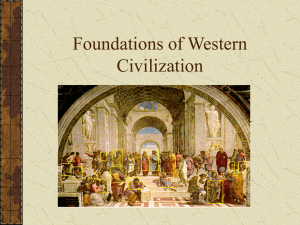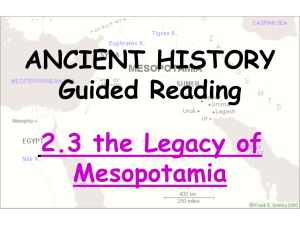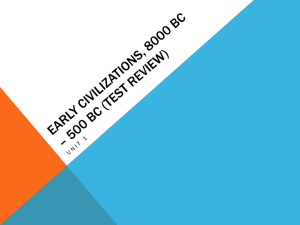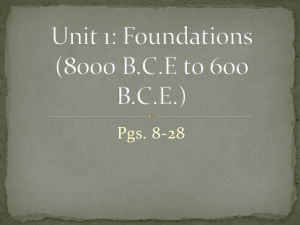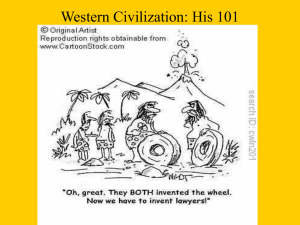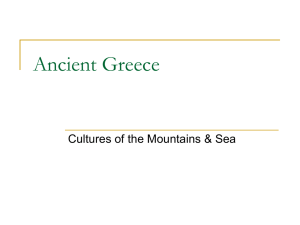Lecture # 3: Ancient Mesopotamian Civilization
advertisement
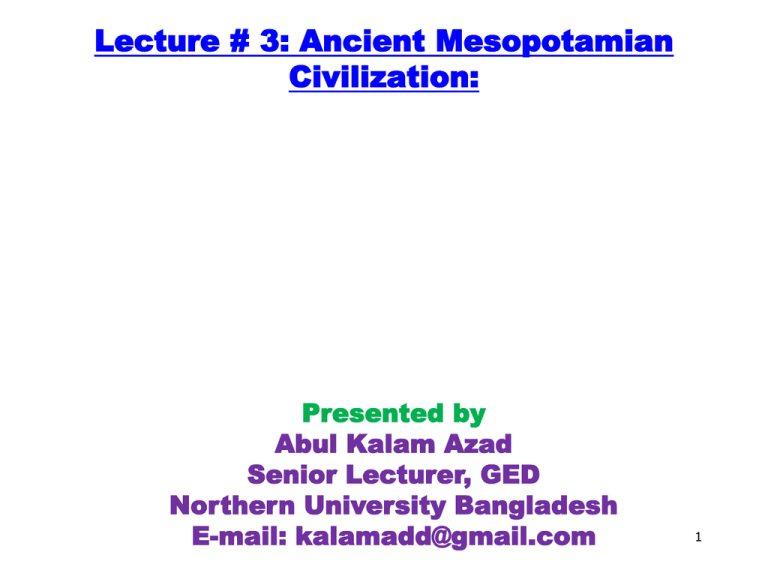
Lecture # 3: Ancient Mesopotamian Civilization: Presented by Abul Kalam Azad Senior Lecturer, GED Northern University Bangladesh E-mail: kalamadd@gmail.com 1 Introduction to World Civilization What was the starting point of civilization? This is the crucial asking to understand the chronology of ancient civilization. There are some debates to get a concrete history of world civilization. According to the existing literature, the most primitive civilization was that of Mesopotamian. Sometimes, this notion seems to be confusing for some writers showed in their analyses that Egyptian civilization was the most ancient. Therefore, we’ll detect the certain point of the introduction to world civilization, firstly, on the basis of Lewis Henry Morgan’s measurement scale, a theory of savagery to barbarism to civilization and secondly, on the timelines of the history. 3 Fig: Successive Stages of History to Morgan Stages Traits Savagery Hunting & Gathering; Technological inventions like fire, bow & pottery Domestication of Barbarism animals; Agriculture; and Metalworking Civilization Alphabet and writing 4 Civilization: Timelines Type Mesopotamian Timelines 4000 BC: Mesopotamian culture & the 1st known writing by the Sumerians 3500 BC: civilization 1st took shape 3100 BC: oldest poetry, first literate civilization Egyptian 4000 BC: Archeological records 3150 BC: unified state & civilization developed around the river Nile 3100 BC: Civilization appears full blown before the First Dynasty; Writing; a solar calendar tec. 5 Ancient Mesopotamian Civilization Mesopotamian civilization is considered as the most ancient civilization on the planet earth. Mesopotamia" is derived from two Greek terms mesos, meaning ‘middle’ and potamoi, ‘rivers’. So, the name literally means ‘land between the rivers.’ Mesopotamia was geographically located between the Tigris and Euphrates rivers, largely corresponding to modern Iraq as well as some parts of northeastern Syria, southeastern Turkey, and southwestern Iran. Due to its fertility, James Henry Breasted regarded this area as "Fertile Crescent”. Map of Mesopotamian Civilization 7 8 1. The Sumerians The first true civilization on planet earth developed in Mesopotamia, and the people who built this first civilization are known as the Sumerians. Ironically, little more than a century ago, nothing was known of the Sumerians. The first civilization in history had been lost to history. Slowly, over the past hundred years, and largely due to the efforts of the Universities of Chicago and Pennsylvania, the puzzle has been slowly pieced together. 9 Features of Sumerian Govt. Society 1. No definite central government ; 2. Few city states were emerged; 3. City states were Free and self dependent e.g., Ur, Lagash, Umma and Nippur; 4. The king of the city state were called the Patesti. He was the chief of the military, irrigation and agriculture system. 1. Three classes were Elite class, Middle class and lowest class; 2. The rulers, the Priests, The Imperial advisors and all the officers were in the elite class; 3. The doctors, the teachers, Small businessmen, landowners and all the labors were in the middle class. 4. All types of the slaves were in the lowest class. Features of Sumerian Culture Architecture 1. Writing system was known as Cuneiform; 2. Different designs or signs/ symbols were developed into graphs representing people, animals, plants temples, gods and cities; 3. They preserved the symbols after burning the plate of mud; 4. Though they introduced the written system, they failed to invent a particular alphabet. 1. Temple served as the home of goddes; 2. Unattractive huts for people but attractive for the priests; 3. They built palaces in different city states; 4. They used bricks in the wall; 5. The symbols of their expert in architecture were in the graveyard; and 6. They also built the graveyard after the death of their king or queen Features of Sumerian Mythology 1. Religion were mainly nature worship; 2. They believed that every God had particular characteristics; 3. They thought that man has been created for the prayer of goddes like Shamash, Enlil (God of the air), Ishtar (goddess of love and fertility and war), Nergal (God of the death), and Enki (Water god and god of wisdom); 4. They thought Shamash as the source of light and temperature; 5. The main temple was called the Ziggurat. 2. The Babylonians (About 1900-1800BC) Over the centuries the ability of the "Kings of Sumer and Akkad" to maintain order in Mesopotamia gradually weakened, a new tribe of Semites began to descend into the Euphrates Valley, just as the Akkadians had done under Sargon. These were the Amorites (an ancient Semitic-speaking people) from Syria near the Mediterranean. They seized the city of Babylon, which is about 50 miles south of Baghdad, the current capital of Iraq. Now at that time Babylon was an insignificant town on the edge of the Euphrates river, but it was there that the Amorites established their capital and their king, thereby establishing what historians know as the Old Babylonian Empire. Eleven kings would occupy the throne of Babylon, and the sixth of these was Hammurabi. 13 Features of Babylonians Govt. Hammurabi Codes 1. Hammurabi reigned from 1792-1750 B.C.; 2. He established his kingdom upon order, justice, and peace; 3. An eight foot column of black stone was engraved with some 282 laws and statutes; 4. The top of the stone shows Hammurabi receiving the law from the sun god, Shamesh 1. The laws were assumed as divine; 2. Judges were appointed to try cases where the principle of “an eye for an eye and a tooth for a tooth” continued to be practiced; 3. Death penalties were common; 4. Conviction for adultery meant death for both parties concerned; Features of Babylonians Hammurabi Codes 5. Women occupied a comparatively high position having own property, equal rights in divorce and bringing lawsuit and being engaged in business; 6. They became professional scribes; 7. Justice to the widow and the orphan was assured; 8. Heavier fines were imposed upon the rich than upon the poor for they could better afford to pay; 9. The lower classes and even slaves were protected by law; 10. Slaves might own property, marry, and will their possessions to their children; and 11. Freedom from bondage was obtained easily. Features of Babylonians Socioeconomic Architecture 1. Highly developed Agriculture; 2. Their most important crops were grape, olive (see next slide), nut, and different types of fruits; 3. Trade was regulated under government supervision; 4. The interest rate, promissory notes, deeds of settlements were well defined. Babylonian architecture has disappeared almost completely. Their main temple Ziggurats were built in stages. There were rooms for Grave etc. Zigurat 17 Features of Babylonians Religion Literature & Learning 1. Their chief god was Marduk; 2. The chief objective of the Babylonians behind their worship were to get more benefits from god to escape their sin; 3. They excused their sin that they were not god and could do no better; 4. They were relatively uninterested in after life; 5. They concentrated on improving man’s existence on earth. 1. Babylonians were highly prized for learning. “He who shall excel in tablet writing will shine like the sun” was one of the most popular proverb in that moment; 2. The people were trained for the work of the temple, school, and other cultural works were encouraged; Literature & Learning Features of Babylonians 3. They were enriched in epic and other literature work; 4. They also developed the poetry that time; 5. Babylonians studied the Mathematics, Astronomy and Astrology; 6. They first introduced the lunar calendar and surveyed the universe. Science and technology ▶Astronomy: The Babylonian astronomers were enthusiastic to study the stars and sky. ▶Mathematics: The Mesopotamians used a sexagesimal (base 60) numeral system. ▶Medicine: The most extensive Babylonian medical text was the Diagnostic Handbook written by the physician Esagil-kin-apli of Borsippa, during the reign of the Babylonian king Adad-apla-iddina (10691046 BC). ▶Technology: They invented many technologies e.g., the wheel. 20 Holidays, Feasts, and Festivals Ancient mesopotamians had ceremonies each month. The theme of the rituals and festivals for each month is determined by six important factors: ▶The phase of the Moon; ▶ The phase of the annual agricultural cycle; ▶ Solstices of the solar year; ▶ The mythos of the City and its divine Patrons; ▶ The success of the reigning Monarch; ▶ Remembrance of specific historical events (founding, military victories, temple holidays, etc.) 21 Family life Mesopotamia across its history became more and more a patriarchal society, in which the men were far more powerful than the women. Thorkild Jacobsen and others have suggested that early Mesopotamian society was ruled by a "council of elders" in which men and women were equally represented, but that over time, as the status of women fell, that of men increased. 22 As for schooling, only royal offspring and sons of the rich and professionals such as scribes, physicians, temple administrators, and so on, went to school. Most boys were taught their father's trade or were apprenticed out to learn a trade. Girls had to stay home with their mothers to learn housekeeping and cooking, and to look after the younger children. Women in Mesopotamia had rights. They could own property and, if they had good reason, get a divorce. 23 Causes of Decline The decay and death of the Mesopotamian civilization can be ascribed to three main causes: the absence of a national government, the foundation by Alexander and his successors of new cities competing with and eventually superseding the older settlements, and the profound ethnic, linguistic, religious and cultural changes introduced by successive waves of invaders --- Persians, Greeks, Arameans, pre-Islamic Arabs --who could neither be kept at bay not assimilated. 24
